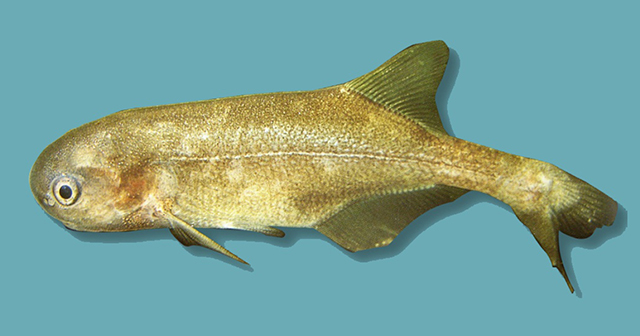| Mormyridae (Elephantfishes) |
| 15 cm FL (male/unsexed) |
|
demersal; freshwater, potamodromous |
| East Africa: Rovuma River system including Niassa Reserve, and western confluences to Lake Malawi (Ref. 91771). Following a recent revision of the Petrocephalus catostoma complex (Ref. 91771), unambiquous evidence for the presence of this species in the Bangweulu-Mweru area (and consequently the Congo basin) is still lacking (Ref. 91772). |
|
Dorsal spines (total): 0-0; Dorsal soft rays (total): 18-22; Anal spines: 0-0; Anal soft rays: 25-28. Description: Body oval shape (Ref. 91771). Head broadly rounded with a small ventrally positioned subterminal mouth, situated ventral to the eye; head and body dorsolaterally compressed (Ref. 91771). Dorsal fin origin situated about two-thirds of standard length from snout, obliquely orientated, anteriorly higher and posteriorly lower, its distal margin crescentic with anterior two or three rays longer than posterior rays; 18-22 dorsal fin rays (Ref. 91771). Anal fin longer than dorsal fin, opposite dorsal fin with slightly more anterior origin, obliquely orientated, anteriorly lower and posteriorly higher, its anterior 10 or so rays longer than posterior ones, especially in males where they also appear stronger, its margin broadly rounded and rays posterior to first 10 with distal margin straight; 25-28 anal fin rays (Ref. 91771). Scales cycloid with reticulate striae, scales extending anteriorly to operculum and pectoral fins; scales on caudal peduncle circumference (Ref. 91771). Caudal peduncle slender, subcylindrical entire length, usually 19.5-23.9% of standard length.
Colour: Grey-silver, underside lighter, paired fins light and transparent, goldbrownish hue on back and tail section (Ref. 91771). In preservation it is light brown, back darker, underside fair (Ref. 91771). |
| Occurs in shallow and muddy waters, sheltered bays, in lagoons, and swampy areas; prefers quiet parts of rivers where there is abundant vegetation (Ref. 13337). Forms shoals (Ref. 13337) within quiet reaches of rivers and floodplains, and with other species with identical electric organ discharge (EOD) waveforms (Ref. 10460). Feeds on insects, found on river bed or in marginal vegetation (Ref. 12526), on insect larvae and other invertebrates at night (Ref. 5595). Known to undergo upriver migration (Ref. 13337, 10608) which may well be correlated with breeding (Ref. 13337). Breeds during the rainy season, possibly moving upstream to suitable sites (Ref. 10608). An unconfirmed report claims the males are territorial and build a nest (Ref. 7248). Caught in nets for food (5214). Oviparous (Ref. 205). |
|
Least Concern (LC); Date assessed: 13 June 2018 Ref. (130435)
|
| harmless |
Source and more info: www.fishbase.org. For personal, classroom, and other internal use only. Not for publication.
